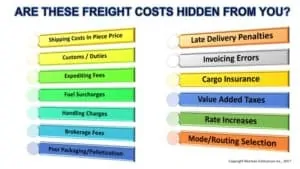Having come from a company wherein we were selling Freight management services I was curious about Freight spend at this new company. But I could find no one answer to my question.
“How much were we spending on Freight?”
The fact that no one knew the answer raised the first alarm bell. The answers that I got raised a whole slew of other alarm bells.
This was going to be an area that was full of opportunity!
Hidden Freight Costs
The reality is that there are freight and logistics costs in every step of the Supply Chain. Part of the problem was that no one had taken, or was responsible and accountable for, a holistic view of freight costs. As such there were a large number of people who affected various elements of freight cost. And they knew nothing about each other.
Hidden Freight Costs In The Piece Price

The first alarm bell sounded when I was told by one business area leader that his freight costs were buried in the piece price of his goods. He had reached an arrangement with a Far East supplier whereby all of his freight costs were included in the bottom line price he was charged. He had no visibility as to what the true portion of his freight costs were.
But he was happy with the arrangement. For him he only paid one price. He didn’t have to negotiate with carriers and manage the entire shipping process. He merely agreed on the price and told the supplier what quantity of items he wanted delivered and on what date. And the goods usually arrived on time.
Interestingly he was also responsible for the profitability of this product line. So why was he so unconcerned with improving his profitability? First he did not have a background in freight and logistics. And there was no expert support organization around to take care of this area. As such he was blind to what was actually going on around him.
The supplier had done a good job on delivery. And the base unit price of the goods was competitive. However when the business owner agreed to have the supplier manage the total cost, including delivery, he had unknowingly given away a tremendous amount of margin and control.
Further there was no one in either the Finance or Logistics function who could see behind the pricing curtain. When the supplier sent in an invoice it was never itemized. Invariably there were a number of hidden freight costs that were buried in the invoice.

Customs and Duty charges were usually split out. Everyone knew that this garnered different accounting treatment. However there was no focus on ensuring that the proper duty charges were made based on correct product classification.
But other charges were not visible. Handling fees, rate increases, penalties, and brokerage fees were not clearly denoted or managed. Carrier rates, insurance, and expediting fees were unclear.
So when invoices came in it was an exercise in forensic science to try to determine if they were correct or not. It was beyond anyone’s ability to figure it out.
And because there was no control or oversight all ability to leverage the freight spend was gone. The total freight bill was huge. It was one of the top 10 expenses in the company. Yet it wasn’t managed at all.
Lost Freight Optimization Opportunities
The loss of control not only means that you are giving away margin but you also are not optimizing your freight. And this optimization often requires your perspective, not that of your suppliers.
There are many considerations for reducing freight costs and your carbon footprint. Selecting the proper shipping mode is a pivotal decision. Planning your freight needs and working in advance with your carriers is essential. And tactical decisions around scheduling, palletization, order management, load consolidation, and delivery timing are critical.
E-Commerce is one area where you really need to control your freight. There are considerations in optimizing packaging, cross docking and drop shipping for instance. Your suppliers are not usually best positioned to optimize this on their own.
One response I’ve heard before is that “Finance will know what the freight costs are.” While all invoices will come in to Finance that does not make them technical experts in this field. It is true that Finance is a critical partner. You need them to help with reporting and analysis. But they are not your go-to Freight management team.
And you require this visibility. I have seen cases where people make isolated decisions in authorizing premium shipping for instance. In doing so they have squandered the entire profit for the products they are rushing in the door. In the past these premiums were a part of the hidden freight costs. As such all accountability was lost. And thus bad decisions were being made.
Conclusion
There are freight costs of some fashion in every part of your Supply Chain. Whether it is inbound shipping, internal processing, or outbound shipping, you are incurring freight costs. And your freight costs are NOT just the rates that your carriers are charging you. There are many, many different and additional fees that are a part of the equation.
While you may want to give a supplier control of your logistics giving them ungoverned control can be problematic. This should be a conscious decision made with cross-functional representation in your organization. And it should be made with a view to the entire cost of freight.
Having the financial reporting in place and organizational responsibility assigned is key. This will allow for a single, holistic view of your total freight and logistics costs. And with that you will make much better decisions.
There should be no hidden freight costs!

